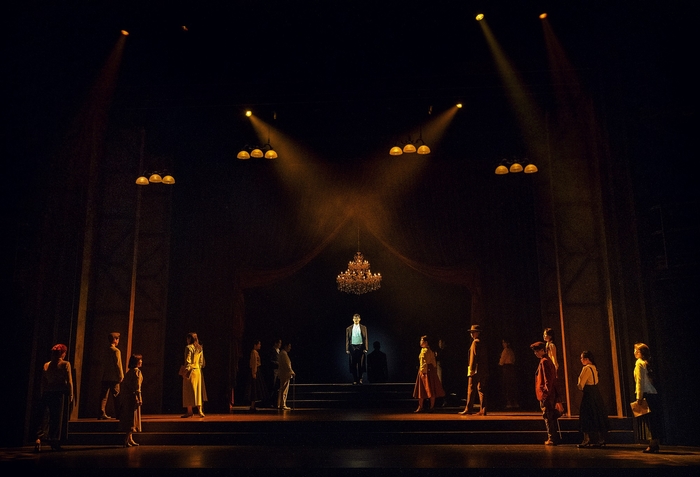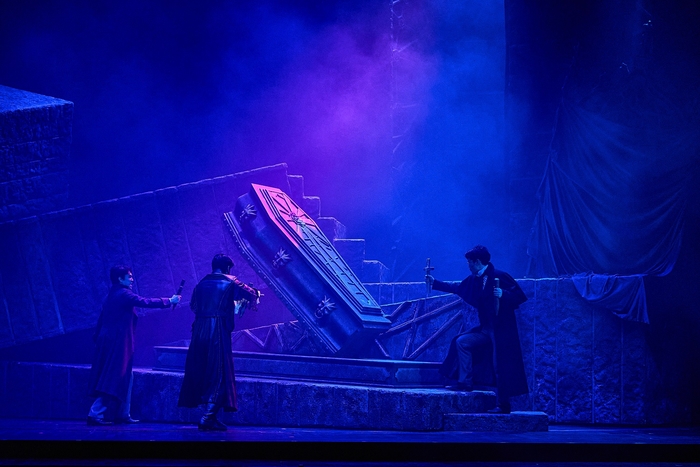Musical ‘Il Tenore’, ‘Dracula’, ‘Marie Curie’, play ‘Temple’.

Watching a performance is a realistic journey into an unknown world. As soon as you enter the auditorium and look at the stage, your heart rate jumps even more when you find that the objects are installed in the proscenium arch (the arch that separates the stage from the auditorium).
The musical ‘Il Tenore’ has a proscenium arch filled with large lighting equipment. This is an element that reveals that it is a meta performance that deals with performances. In ‘Dracula’, statues that look like old corpses surround the entire stage. I get chills when I sit in the audience. ‘Marie Curie’ visualized the radium element discovered by Madame Curie through a laboratory painted in luminous green. It is a setting that arouses interest in radium and radiation. The play “Temple” hangs all over the empty space with windows and ladders. This suggests that it is a work that deals with the communication of the main character who shows symptoms of the autism spectrum.
These works, which are currently being performed, are all different in content and genre, but they have something in common that the main characters who have voiced their opinions back in time. It contains the process of overcoming difficulties and revealing their dreams or their voices. The change of phase through changes in stage art in the second half leads the audience to accept it through various senses such as sight, hearing, and texture. For the audience, it is also a moment when they face an unexpected new world while traveling comfortably.
“Il Tenore,” which deals with the independence movement through opera production, is a purely Korean creative musical based on the motif of Lee In-sun (1907-1960), the first tenor of Joseon who was a doctor. Before and after 1937, when the Korean language was banned, it depicted the process of performing the first opera of Joseon by students and artists in solidarity to protect Joseon’s identity and promote the spirit of anti-Japanese.

Most independence movement narratives are dark, but ‘Il Tenore’ begins with laughter. The process of Yoon I-seon, who attended Severance University and was active in the literary club, encounters vocal music and undergoes a great awakening as a vocalist rather than a doctor, elicits applause from the audience. Yoon I-seon, who is contemplating whether to become a doctor or a vocalist, an architecture graduate who advocates an armed independence movement, and Seo Jin-yeon, a female leader who believes that the cultural independence movement comes first, participate in the ‘Crow Assassination Operation’, which involves executing Japanese leaders during the production of the Italian opera ‘Dreamers’. plan.
The entire stage rotates half and full, transforming the simple student performance hall into Bumin-gwan, the best theater of its time, and decades later into a theater dedicated to opera in Korea, a developing country. It is not a simple stage rotation, but a transition of the entire theater. It is also a shift in dreams toward a new phase.
The original Bram Stalker, Broadway version of the licensed musical “Dracula,” is a work that boasts a thick fanbase that reaches its fifth season since its Korean premiere in 2014. It contains a heartbreaking love story of Dracula, who tries to win Mina in her reincarnated life, and Mina helping a vampire hunter. The highlight of the work is the tracking down of Dracula by vampire hunters such as Van Helsing and Jonathan. The four rotating stages, in which time and space travel from Mina’s house to London Street and back to Dracula’s mansion, alternate, lead to a spectacular scene where nine giant pillars and sets of mansions intersect. Audiences who witness this on a live stage cannot take their eyes off the novelty of the actors who dangerously cross between huge sets. Hunters try to put a cross in the coffin where Dracula sleeps, but Dracula, who floats or crosses different time and space in the coffin, reveals that she is still immortal.
After discovering the portrait of Dracula and Elizabeth 400 years ago, Mina awakens her past life as Elizabeth and promises love to Dracula. However, realizing that Mina’s immortality is death forever, Dracula chooses to die for herself. This huge stage prop, which turns into a different portrait depending on the cast, is a stage device for a phase change that eventually leads to tragedy as Dracula and Mina awaken in different directions along with rotating time and space.

The musical “Marie Curie” presents stage art in a different aspect from large-scale works in which the entire stage is reversed. It is a Korean creative musical about the life of Mrs. Curie, who won the Nobel Prize in Chemistry for discovering radium, and it is the third season since its premiere in 2020. It is also a full-fledged scientific musical about Marie Curie’s decision to face the ambivalence of radium and social and political dilemmas in the early 20th century and the changes of people around her.
Despite the fact that it feels difficult because there are many jargon in the lines and numbers, the reason why it has been well received in Poland, the UK, Japan, and China is the power of narratives dealing with justice, conscience, and love for humanity. Along with beautiful numbers and probable composition, the power of stage art to intuitively accommodate radium is also great. The life of Marie, who demonstrated the ambivalence of radium with her whole body, extends to the luminous green stage, a symbol of radium. The moment Marie Curie herself decided to represent the workers who were sacrificed by radiation and to be evidence of danger was visualized as a stage transition in which the light of green rays disappeared.

“Temple,” a play about the autobiographical story of a zoologist who overcame the autism spectrum and designed more than half of animal facilities in the U.S., is a work itself. The life of Temple, who remembers everything only through images, is expressed through window objects and body movements that symbolize communication. It satirizes the prejudice of psychiatrists at the time, who claimed that the body language of actors close to acrobatic was “caused by cold parents.” The stage art and physical movements that break down the barriers of numerous prejudices that shaped Temple’s life provide an analog experience to the audience. I also thought that it was like a drop of lubricant in a society lacking communication.
The long Lunar New Year holiday is just around the corner. In addition to being meaningful, if we have a meaningful discussion with our relatives while watching these works, which provide various sights with spectacular and delicate stage arts, could it be an opportunity to form solidarity with our relatives. The lives of young people in Japanese colonial era who had dreams through the first opera performance in the Joseon Dynasty (Il Tenore), the determination of an imposing woman who voices in prejudice (Dracula and Marie Curie), and the new way of empathizing with the power of communication (temple) are also related to the attitude of life that we need in the same era of 2024.
Source Weekly.khan
Trans/Shared by : Musical In Life